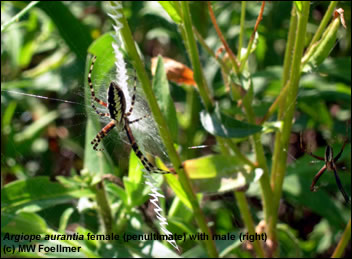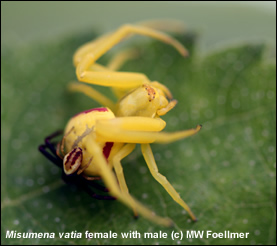| Matthias W. Foellmer |  |
Evolutionary Ecology and Diversity of Spiders |
||||||
|---|---|---|---|---|---|---|---|---|
|
|
||||||||
| Sexual dimorphism | |
Currently our focus is to gain an understanding of the factors that drive - and constrain - the evolution of sexual size dimorphism (SSD) using the spiders (Araneae) as a model group. Sexual size dimorphism, defined as a difference in the mean body size between adult males and females, is the most prominent manifestation of sexual dimorphism in the animal kingdom, with most animals expressing some degree of SSD. Importantly, SSD provides an excellent general model to understand evolutionary processes. This is because body size is one of the most important quantitative traits of an organism; it is strongly correlated with many physiological, behavioral and fitness traits. Natural selection (through the combined effects of sexual selection, fecundity selection and viability selection) often favors a different optimal body size in males and females of a given species, ultimately as a result of the different reproductive roles of males and females. However, body size is determined largely by the same set of genes and developmental pathways in the sexes, leading to intralocus sexual conflict. Thus, genetic and developmental, as well as physiological and phylogenetic constraints pose limits to the evolution of SSD, and it has recently been suggested that intralocus sexual conflict may indeed persist in populations and profoundly affect evolutionary dynamics to a much greater extent than previously thought. Any manifestation of SSD therefore provides evidence of powerful natural selection processes which need to be analyzed as an important step towards understanding biological diversity. |
|
With respect to the pattern of SSD in nature some trends can be observed: in most mammals and birds, males are the larger sex, whereas in ectothermic vertebrates and invertebrates females are typically larger. However, there is an astonishing range and variability of SSD not only across higher taxa but also among closely related species. The spiders are particularly remarkable, because it is the terrestrial taxon with the largest range and most spectacular cases of SSD. Sexual size dimorphism ranges from male-biased to extremely female-biased with females weighing more than one hundred times as much as males in several species – a degree of SSD that is otherwise only observed in some marine groups such as angler fish or bonellids. In addition, this extreme SSD has evolved several times independently within the spiders and male and female body sizes exhibit an unusually uncorrelated evolution within some groups such as orb-web spiders. These features have made the spiders a model group for the study of SSD evolution in recent years. For a recent review of the evolutionary significance of SSD in spiders see Foellmer & Moya-Laraño (2007) and for current (and past) projects see Publications and People. |
 |
 |
 |